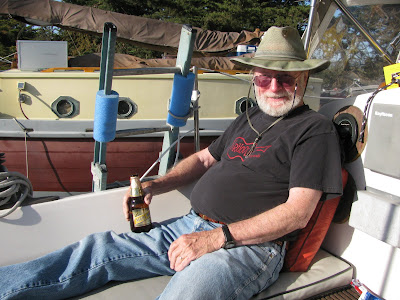
Camp Connell, Ca -- Back in the days when Pat and I were newlyweds living the good life on the beach in Florida, we had an unlikely neighbor named Martin Caidin.
We all lived in a beachfront apartment on Cocoa Beach, next door to Cape Canaveral. The Twin Towers was close to everything: the beach was a hundred yards away; the pool was outside our window; the NASA office where Pat worked was next door, and there were a half dozen bars and clubs within easy distance.
And Martin lived just above us.
He was hard to ignore, a man who worked hard at being colorful. He was loud, profane, funny and very entertaining. And smart.
 Martin at the broadcast console
Martin at the broadcast consoleOnce when Martin saw someone trying to break into a car in the parking lot three stories below his balcony, he grabbed a pistol loaded with blanks, shouted "STOP THIEF!" and proceeded to blast away. The apartment was in an uproar, but the neighbors agreed the thief probably would never bother us again.
One night we heard Martin's voice, yelling at everybody, but it seemed to be coming from up in the air outside. It turned out he was flying his bi-plane that night, decided to cut the engine and float between the six-story towers and wake up his neighbors. He thought that was really funny.
Another time when Pat and I walked into Wolfie's, the local eating and drinking spot, Martin stood up and shouted to everyone that Pat -- who had great posture and a dancer's body --had "the best-looking damned legs in the state of Florida." He also climbed up on a table to yell for service when the waiter failed to show up.
According to Martin he had written and published over 60 books at the time, mostly non-fiction military and aviation books, as of the mid 1960s.
He was always working on a new novel. He was not rich at the time, churning out books that sold a few but not a lot, but he managed to keep a junky old car running and his alimony paid. And his airplane.
 Junkers JU52 restored by Martin, who claimed it was used by Hitler
Junkers JU52 restored by Martin, who claimed it was used by HitlerMartin worked for various news agencies, mostly doing broadcasting during launches of manned space missions. He was the "color" expert, rattling off personal tales of encounters with astronauts or technical details of giant rocket systems with ease. When I was drafted into doing radio broadcasts by my newspaper he offered me great advice: "Act like you know what you are talking about and everyone will believe you."
He was successful enough at the time to rent two one-bedroom apartments, knock out a wall between them, and created a living work space.
Martin's background was a little fuzzy. Everyone knew he was a pilot, and he let people think he had flown in the war (WW 2 or Korea was never clear). When I pressed him one time, prompted by a picture of him in fatigue uniform in the Pacific, he said he had been a sergeant in the Army Air Corps.
In later years he became recognized as an expert on warfare, aviation, nuclear weapons (including a stint on the Tonight Show), biomedical research, and a world of other stuff. He could sell himself to anyone, and even if you suspected some of it might be BS you enjoyed every moment.
He was extremely smart, and his expertise came from a mind like a sponge. He read everything he could get his hands on, and used his great memory and work ethic to develop a writing technique I'd never seen before. In his home/office he had a giant wall unit with cubbyholes, maybe fifty of them, filled with technical papers, notes, government handouts, clippings. Once he decided on a plot for a novel, he began collecting everything he could find on the subject and popped it into a cubbyhole with a chapter number.
For a novel involving terrorists building a nuclear weapon, he collected government handouts from a wide range of agencies.

For a science-fiction novel about a man with artificial parts ("Cyborg," the basis for the TV series The "Six Million Dollar Man") he collected all the biomedical and technical data he could find on bionics.
When he had enough data collected, and the plot in his brain, he would sit down at the typewriter and start pounding out the book. He said he could type 20,000 words in one day, but I never had a chance to test that. I know he could write a novel in about six weeks, particularly if he was broke.
His system worked. The books were not great art, but he told good stories well.
I treasure one novel where he gave me credit in the foreword for a description of the wilderness surrounding the Cape Canaveral launch pads, based on a magazine article I had written. He didn't ask permission, of course, but he gave me credit.

By the time Martin died he had written at least 80 books, including "Marooned," made into a movie with Gregory Peck, Gene Hackman and Richard Crenna. The money from movie rights was enough to improve his situation financially, and then he did "Cyborg" the television rights and royalties made him wealthy for the first time. He was even hired to write two books in the Indiana Jones series.
After we left Florida Martin married the young daughter of a British witch, and eventually moved to the University of Florida as a writer in residence. He died there of cancer shortly after finishing the Indiana Jones books.
Not a bad ending for a hard-working orphan boy from New York City.

















